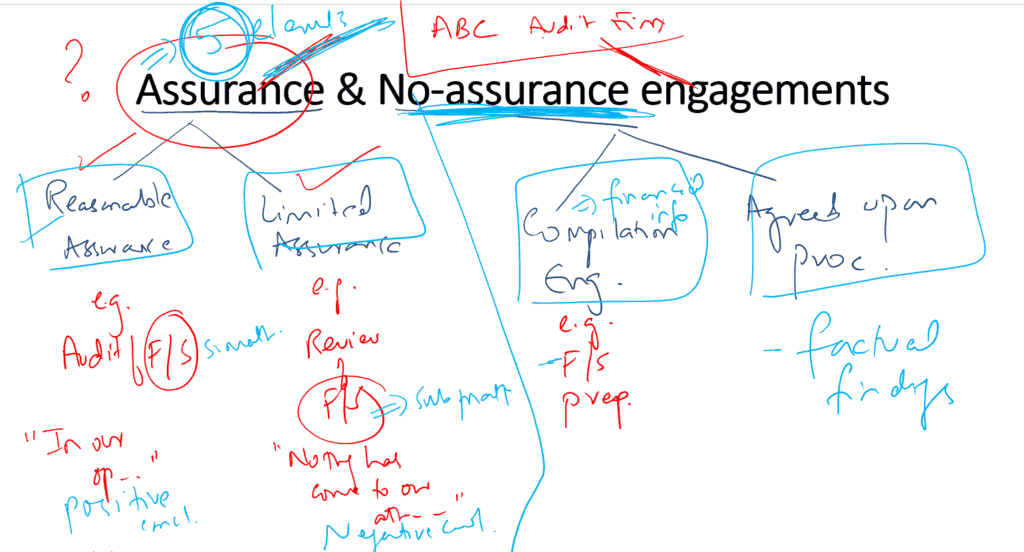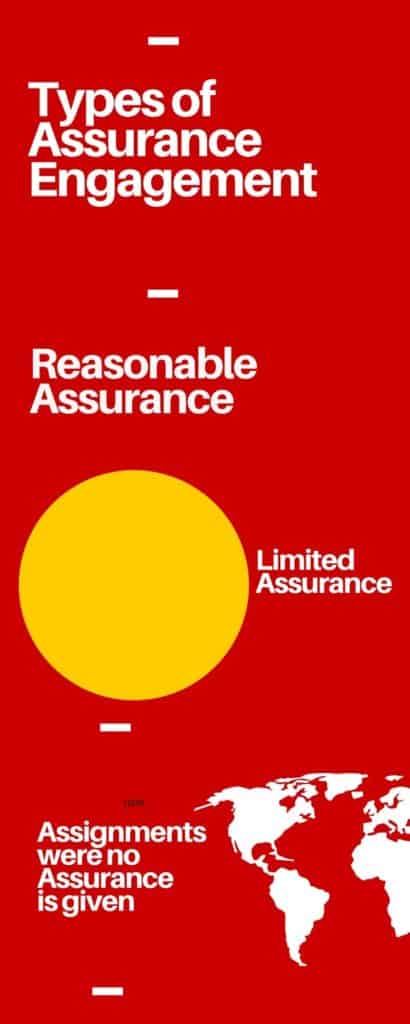What is assurance & Types of Assurance Engagement
What is Assurance Engagement:
Assurance Engagement Definition: Any assignment/engagement which has five elements(Below) becomes an assurance engagement
Five Elements of an Assurance Engagement
| A three-party relationship, involving: the practitioner, a responsible party and intended users. |
| Appropriate subject matter. |
| Suitable criteria. |
| Sufficient, appropriate evidence to support the conclusion. |
| A conclusion contained within a written report. |
- An assurance engagement will require a three-party relationship comprising:
- a) The intended user who is the person who requires the assurance report (Share Holders, Lenders, etc, etc)
- b) The responsible party, which is the organization responsible for preparing the subject matter to be reviewed (Board of Directors)
- c) The practitioner who is the professional who will review the subject matter and provide assurance. (i.e. an accountant)
- The second element is required for an assurance engagement is a suitable subject matter. The subject matter is the data that the responsible party has prepared and which requires verification (e.g Financial statements)
- The subject matter is then evaluated or assessed against suitable criteria in order for it to be assessed and an opinion provided (e.g IAS & IFRS)
- The practitioner must ensure that they have gathered sufficient appropriate audit evidence in order to give the required level of assurance engagement.
- In the last one, an assurance report provides the opinion which is given by the practitioner to the intended user(ShareHolders)
Types of assurance Engagement
Difference between audit and assurance OR Assurance meaning in accounting OR Types of assurance services
Types of Assurance assignments


Reasonable Assurance
| An Assurance engagement in which the Practioner(Auditor) reduces engagement risk to an acceptably lower level in the circumstances of the engagement as the basis for the practitioner’s conclusion. |
|---|
| Example: External Audit |
| High level of assurance but NOT absolute or 100% A high level of assurance but not the absolute level of assurance is provided, this is known as reasonable assurance. |
| More testing (Analytical procedures, a test of controls and substantive testing) Going concern review also carried out |
| Positive conclusion- Wording: ‘in our opinion, the financial statements give (or do not give) a true and fair view of the state of the company’s affairs’. |
Limited Assurance
| An assurance engagement in which the practitioner(Auditor) reduces engagement risk to an acceptable level in the circumstances of the engagement but where that risk is greater than for a reasonable assurance engagement |
|---|
| Example: Review of financial statements |
| Moderate level of assurance The practitioner gathers sufficient appropriate audit evidence to be satisfied that the subject matter is credible, in this case, negative assurance is given whereby the practitioner confirms that nothing has come to auditor's attention which indicates that the subject matter contains material misstatements in financial statements |
| Lesser testing-focus on obvious errors only (Analytical testing and Enquiry) Going concern review will not be performed The procedures undertaken are not nearly as comprehensive in assurance engagement, with procedures such as analytical review and inquiry used extensively. Also, the practitioner does not need to comply with ISAs And IFRSs as these only relate to external audits. |
| Negative conclusion-Wording: “Nothing has come to light to suggest errors or problems exist’' However, the assurance is given in the absence of any indication to the contrary. |
| Review engagements are often take up as an alternative to an audit and involve a practitioner reviewing financial data, such as six-monthly figures. This would involve the the practitioner takes up procedures to state whether anything has come to their attention which is the reason the practitioner to believe that the financial data is not in accordance with the financial reporting framework. |
Assignments were no Assurance is given
| Agreed-upon procedures: A report on factual findings is given but assurance will not be given. Users must judge for themselves and draw their own conclusions |
|---|
| Compilation engagement: Users of the compiled information gain benefit from the accountant’s involvement but no assurance is expressed. It is used to collect, classify, and summarise financial information. It means to present data in a manageable and understandable form |
See also: Ratio Analysis
